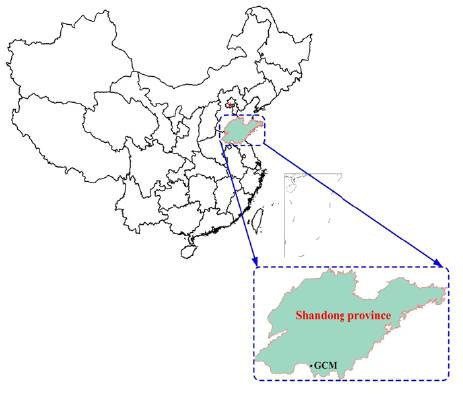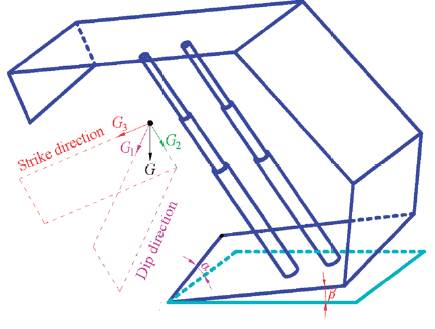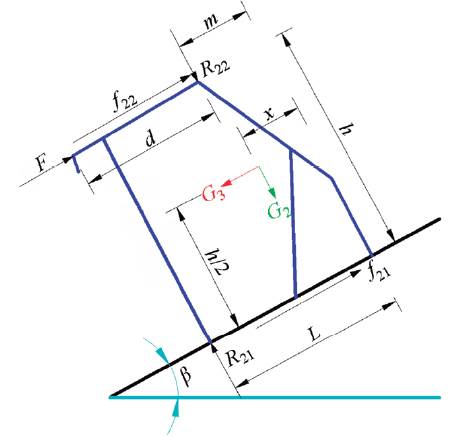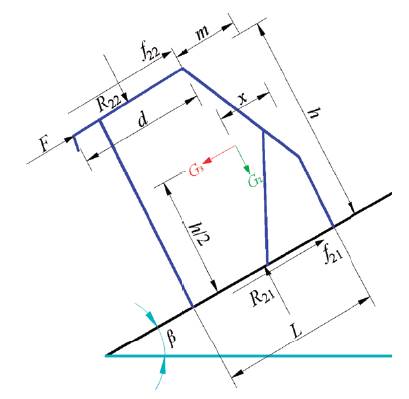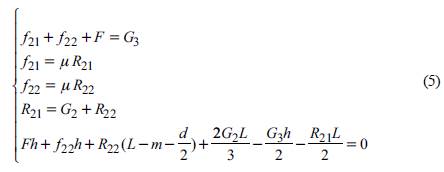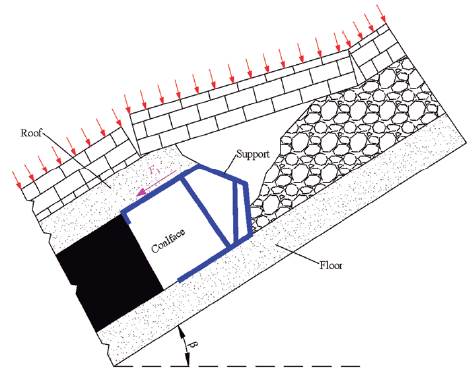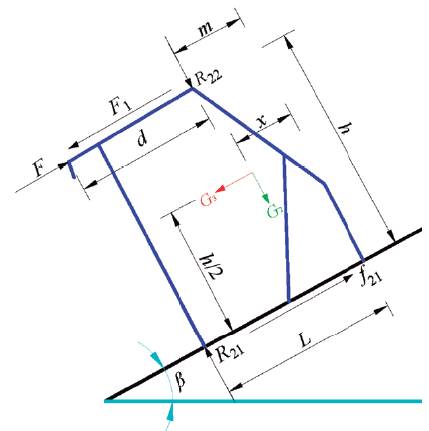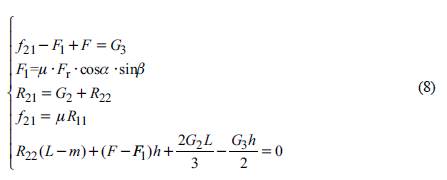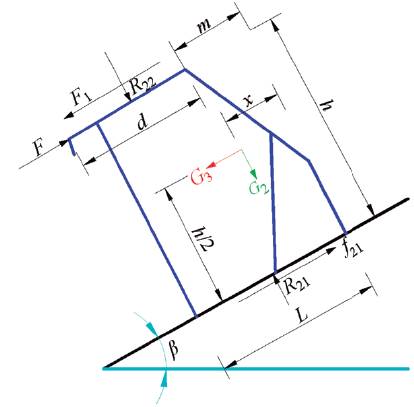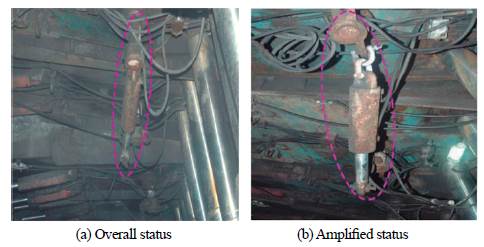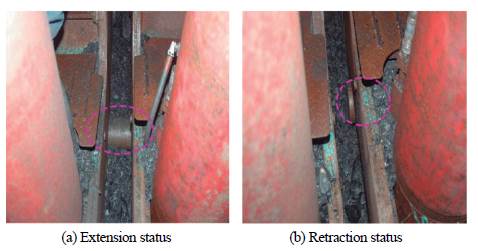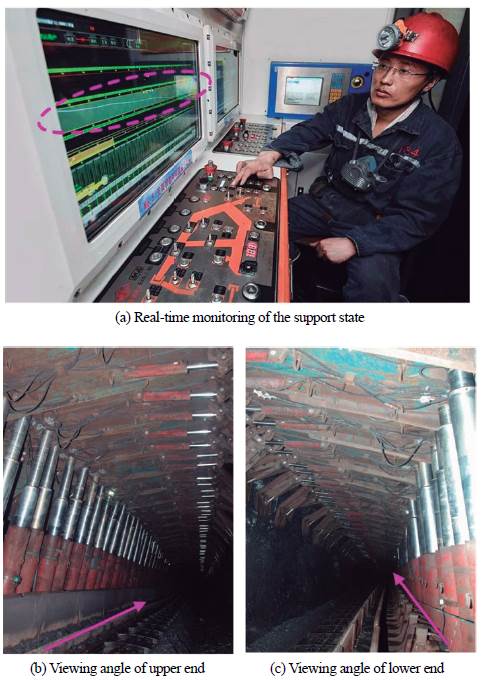Introduction
Coal is still the major energy source in China, occupying more than 60% of the total energy consumption (Huang et al., 2017; Zhang et al., 2019). Along with the improvement of China's planning on strategic coal reserves and the exhaustion of high-quality coal resources with good occurrence conditions, the need for coal mining under complex geological conditions has been growing. In China, mineable reserves of steeply inclined coal seams account for approximately 17 % of the total coal reserves (Chi et al, 2019; Tu et al., 2015; Wu et al., 2000; Wu et al, 2014). The large dip angle coal seams (LDACSs) are mainly located in Sichuan, Xinjiang, Ningxia, Gansu, Inner Mongolia, and Heilongjiang provinces. Due to a series of technical difficulties such as violent underground pressure behavior, complex rule of overburden movement, and difficult control of coalface roof (Tu et al., 2015; Wang et al., 2011; Yun et al., 2017; Yin et al., 2001; Zhang et al., 2019), the mining technique for LDACSs is much less developed compared with the mining technique for the gently inclined coal seams.
The commonly used mining methods for thick coal seams in China are slice mining, top coal caving mining, and large cutting height mining (Tu et al., 2009). Slice mining is a conventional mining method, in which multiple mining operations will cause coalface roof broken, making it difficult to control, while top coal caving mining is an advanced method that greatly increases the mining efficiency of thick coal seams (Deng et al., 2015; Klishin & Klishin, 2010; Singh et al., 2002; Wu et al., 2008; Wang et al., 2019). However, top coal caving mining has some inherent drawbacks, such as low recovery rate of coal resources, susceptibility to spontaneous combustion of coal seams, and a considerable amount of coal dust in the working space. Recent years have witnessed a constant advancement in the research and development of coal mining machinery, accelerating the application of large cutting height mining while improving the level of fully-mechanized mining of thick coal seams (Rakesh et al., 2015; Wang, 2014). For thick LDACSs, large cutting height mining can greatly increase the coal recovery rate, reduce refuse content and dust production rate of the coalface (Yang et al., 2015). But it should be pointed out that, support tilting and sliding are usually the major factors that restrict the use of large cutting height mining (Lin et al., 2004; Wang & Jiao, 2016; Yuan et al., 2015; Yang et al., 2018; Zhang et al., 2019). To ensure safe and high-efficiency production of the mine, it is necessary to assess the support stability in the coalface under the corresponding conditions.
Compared with the gently inclined coal seams, the mining of LDACSs causes a reduction in the normal component and an increase in the tangential component of support's gravity (Singh & Singh, 2009; Tu et al., 2008). The reduction in the normal component leads to a reduction in the weight that the support can bear and hence a smaller working resistance of the support. A high tangential component will cause an increase in the sliding power acting on the support along the inclination direction of the coalface. As a result, support is likely to tilt and slide. At present, many studies have been conducted on support stability along with the dip of the large dip angle coalface (LDAC). However, support stability in LDAC is not only affected by the dip angle of the coal seams, but also by the strike angle of the coal seams (i.e. underhand or overhand mining). Moreover, during the SMP (e.g. passing through faults and other tectonic zones) (Li & Zhou, 2018), the stress condition of the support is also different from that during the NMP (Hosseini et al., 2017; Hua & Wang, 2008; Ma et al., 2015; Ostayen et al., 2004; Wang et al., 2015; Wu et al., 2014). In particular, the support in the coalface is subjected to large lateral stress imposed by the roof, which will greatly reduce the support stability (Li et al., 2017). In this study, based on the specific mining conditions of the #3up509 coalface with LDA and LMH of the GCM, Zaozhuang Mining Area, China, The stress characteristics of support in the coalface are analyzed, and the mechanical models for support tilting and sliding are respectively developed. Using these two models, the support stability along the strike of the coalface is assessed during the NMP and the SMP. Furthermore, the influencing factors of support stability along the strike of the coalface are discussed. Finally, some countermeasures for preventing support tilting and sliding are proposed, to ensure the safe and high-efficiency mining of the #3up509 coalface, and achieve good technical and economic benefits.
Overview of mine and mining conditions
The GCM, one of the main mines of Zaozhuang Mining Group, is located in the southwest of Tengnan Coalfield. The coal mine under investigation is located in Weishan County, Shandong province, China. The geographic location of the GCM is shown in Figure 1. The north-to-south distance of the GCM is 8.50 km and the west-to-east distance is 2.50-5.50 km, with an area of 32 km2. The GCM is situated in a monocline, with a northeast-southwest strike and a dip angle of 5°-18°, the maximum being 25°. The dip angle gradually decreases from the southeast to the northwest. The coal-bearing strata are Permo-Carboniferous systems consisting of five exploitable coal seams (#3up , #3down. , #12 up , #16, and #17 coal seam). The #3 up and #3 down, coal seams are the main mineable coal seams. Multi-level vertical shaft development is implemented, with centralized appose ventilation. The production levels of the GCM are -370 m and -430 m, and #3 up and #3 down, coal seams are mainly exploited.
The #3up509 coalface of GCM is located in the western fifth mining district at the level of -430 m. On the south is the #3 up 507 coalface in which extraction has been completed; on the north is the level of -600 m which is to be extended; the east side is close to the Shaoji Fault, and the west side is the down-dip entries of the western fifth mining district. The length of the #3up509 coalface along the strike is 1180 m, and 220 m along with the dip. The mining area is 259600 m2, and the corresponding ground elevation is +32.76-+33.70 m; while the underground elevation is -244.6--414.0 m. The coalface is located in the #3 up coal seam of the Permian Shanxi series in a monocline. The density of the coal seam is about 1.35 t/m3, and the thickness is 3.75-6.20 m, with an average of 5.20 m. A gangue layer about 0.30 m thick is observed locally. The dip angle is 12°-31° with an average of 19°, indicating that the coal seam is a typical LDACS. The roof is mainly composed of mudstone and sandstone, and the floor is predominantly of siltstone. The tectonic development of coalface revealed a total of nineteen faults. Among them, nine faults have a throw over 2.0 m, where the maximum throw is 12 m. Inclined longwall mining (underhand mining) is implemented (average mining height 5.0±0.1 m), and the maximum angle of the underhand mining is 10°. Goaf roof is managed by the all-collapse method. Two-leg shield support (ZY6600-25.5/55) is used for the coalface, with a maximum height of 5.50 m and a minimum height of 2.55 m, with a center distance of 1.5 m, as well as with the rate-setting load of 5067 kN and rated working resistance of 6600 kN.
Stress characteristics of support in the coalface with LDA and LMH
Large mining height supports usually have poor stability. Moreover, due to the different movement states of the roof, support, and floor in the LDAC and underhand mining operation (Zhang & Cao, 2015), support stability usually decreases dramatically. The components of self-gravity associated with large mining height support in the LDAC using an underhand mining method are illustrated in Figure 2.
It can be seen from Figure 2 that the self-gravity (G) of large mining height support has component G 1 (along with the dip of the coal seam) and G 3 (along the strike of the coal seam), positioned perpendicular to each other. The presence of these two components is not conducive to the stability of the large mining height support. In contrast, component G 2 along the normal direction of the coal seam can promote support stability. The support stability is jointly affected by the dip and strike of the coal seam. If only component G 1 is considered in calculating the support stability along the strike, then the influence of component G3 on the support stability will be neglected. To make the analysis of support stability more accurate, both the strike and dip of the coal seam are considered. Here, the resultant force of components G 1 and G 3 is newly introduced as G 3 into the equation for support stability along the strike. This can ensure a certain safety factor. From the geometric relationship in Figure 2 and the aforementioned mechanical simplification, the following equations are derived.
Where α is the dip angle of the coal seam; and β is the angle of the underhand mining.
Mechanical analysis of support stability along the strike during the NMP
The NMP refers to that there is no severe situation affecting the safety production of coalface in advance. For example, the accident of local roof caving does not occur in the coalface. During the NMP, the roof of the coalface with LDA and LMH is usually intact, and it will produce a frictional force on the large height support beam that prevents the support from tilting and sliding. Under the influence of the friction force, the instability possibility of the large height support in LDAC will be greatly reduced. In this section, the support stability of LDAC along the strike during the NMP has been analyzed by the mechanical models of support tilting and sliding.
Mechanical model of support tilting
The mechanical model of support tilting along the strike of the coalface during the NMP (underhand mining) is shown in Figure 3.
From Figure 3 the following stress state equations of support are derived:
Solving the above equations will yield the equation for the critical support tilting angle:
Where M = R 22 m-LR 22 - Fh - R22 p h ; N = 16GL 2 + 9Gh 2 ; G is the self-gravity of the support, taken as 260 kN; F is the support force imposed by the coal wall on the support; μ is the coefficient of friction between the support and the stratum, taken as 0.30; d is the length of the support beam, taken as 4.11 m; m is the distance between the tail of the support beam and the tail of the support base, taken as 1.43 m; L is the length of the support base, taken as 3.19 m; x is the distance from the center of gravity of the support to the tail of the support base, taken as L/3; R22 is the support resistance of the support (setting load or working resistance).
In Equation 3, underhand mining status during the NMP, the critical support tilting angle (β) is inversely proportional to the self-gravity of support (G), mining height (h) of the coalface, and dip angle (α) of the coal seam; it is directly proportional to the coefficient of friction (μ), length of the support base (L), support resistance (R 22 ) of the support, and the support force (F) imposed by the coal wall to the support. Introducing the support-related parameters of the #3up509 coalface into Equation 3 and letting F=0 (i.e. the coal wall provides a small support force to the support, so its influence on support stability is neglected), it is calculated that the minimum R22 is 52.20 kN (i.e. the minimum initial support force or the force of support displacement with pressure is not below 52.20 kN). That means the support will not undergo tilting along the strike.
Mechanical model of support sliding
The mechanical model of support sliding during the NMP (underhand mining) is shown in Figure 4.
From Figure 4 the following stress state equations of support are derived:
Solving the above equations will yield the critical support sliding angle:
Where M = F + 2 μR22 ; G is the self-gravity of the support, taken as 260 kN; F is the support force imposed by the coal wall on the support; p is the coefficient of friction between the support and the stratum, taken as 0.3.
In Equation 6, underhand mining status during the NMP, the critical support sliding angle (β) is inversely proportional to the self-gravity (G) of support and dip angle (α) of the coal seam; it is directly proportional to the coefficient of friction (p), support resistance of support (R22) and the support force (F) imposed by coal wall onto the support. Introducing the support-related parameters of the #3up509 coalface into Equation 6 and letting F=0, it is calculated that the minimum R22 is 183.75 kN (i.e. the minimum initial support force or the force of support displacement with pressure is not below 183.75 kN). That means the support will not undergo sliding along the strike.
Mechanical analysis of support stability along the strike during the SMP
The SMP refers to that there are some severe situations affecting the safety production of coalface in advance, e.g. failure of the main roof caused by its weight, and coalface cutting through a fault, the coalface roof is likely to break up. Due to the dip angle influence of the coalface, the breaking roof will have a downward trend. In this case, the roof will produce considerable lateral stress (F 1 ) on the large height support beam (see Figure 5), which has a severe adverse impact on support stability. Moreover, due to the rib spalling influence of the large height coalface, this lateral stress (F 1 ) will aggravate the deterioration of the relationship between the support and surrounding rock, and seriously affect the normal production of LDAC. In this section, the mechanical models of support tilting and sliding have been established separately, and the support stability of LDAC along the strike during the SMP will be analyzed.
The lateral stress imposed by the roof on the support should be processed as follows when performing mechanical analysis of the support stability along the strike. The overlying strata above the caving zone can form a structure. So the pressure borne by the support mainly comes from the weight of the overlying strata within the caving zone (Klishin et al., 2013; Miao et al., 2011; Zhang et al., 2018). Based on the mining conditions of the #3up509 coalface, the pressure imposed by the roof onto simple support (Fr) is calculated as F=yh. xlixb=25.0x10.4x6.0x1.5=2340 kN (where y is volume force of overburden, taken as 25 kN/m3; h is the thickness of immediate roof, taken as 10.4 m; l is the hanging length of the immediate roof, taken as 6.0 m; and b is the support width, taken as 1.5 m). That is, the total pressure imposed by the roof to single support is 2340 kN. Using the method for decomposing the support's self-gravity in Section 3, the pressure imposed by the roof is decomposed in three directions, namely, in parallel with the strike of the coalface, in parallel with the dip of the coalface, and perpendicular to the floor of the coalface. The same method of mechanical simplification is implemented to obtain the lateral stress imposed by the roof to a single support.
Mechanical model of support tilting
The mechanical model of support tilting during the SMP (underhand mining) is constructed as in Figure 6.
From the perspective of the support mechanism, the tilt hydraulic support cannot normally provide support resistance to the coalface. It is inappropriate to refer to R22 as the working resistance, but the normal component of Fr. Then from Figure 6 the following stress state equations of support are derived:
Solving the above equations will yield the critical support tilting angle:
Where M = LR 22 + Fh -F x h -R 22 m ; N = GQ.6L 2 +9h2) ; G is the self-gravity of the support, taken as 260 kN; F 1 is the lateral stress imposed by the roof onto the support beam; F is the support force imposed by the coal wall on the support; μ is the coefficient of friction between the support and the stratum, taken as 0.30; d is the length of the support beam, taken as 4.11 m; m is the distance between the tail of the support beam and the tail of the support base, taken as 1.43 m; L is the length of the support base, taken as 3.19 m; x is the distance from the center of gravity of the support to the tail of the support base, taken as L/3; R 22 is the normal component of F r .
According to Equation 9, underhand mining during the SMP, the relations between the critical support tilting angle (β) and other factors are consistent with those during the NMP. However, it is directly proportional to the lateral stress (F 1 ) imposed by the roof onto the support beam. Introducing F1=1254 kN and the support-related parameters of the #3up509 coalface into Equation 9 and letting F=0, it is calculated that the minimum R22 is 229.7 kN (i.e. the minimum initial support force or the force of support displacement with pressure is not below 229.7 kN). That means the support will not undergo tilting along the strike.
Mechanical model of support sliding
The mechanical model of support sliding during the SMP (underhand mining) is developed, as shown in Figure 7.
From Figure 7 the following stress state equations of support are derived:
Solving the above equations will yield the critical support sliding angle:
Where M = F[ - F - p R 22 ; G is the self-gravity of the support, taken as 260 kN; F 1 is the lateral stress imposed by the roof onto the support beam; F is the support force imposed by the coal wall on the support; μ is the coefficient of friction between the support and rock stratum, taken as 0.30; R 22 is the support resistance of the support (setting load or working resistance).
According to Equation 11, underhand mining during the SMP, the relations between the critical support tilting angle (β) and other factors are consistent with those during the NMP. However, it is inversely proportional to the lateral stress (F 1 ) imposed by the roof onto the support beam. Introducing F1=1254 kN and the support-related parameters of the #3up509 coalface into Equation 11 and letting F=0, it is calculated that the minimum R22 is 4425 kN (i.e. the minimum initial support force or the force of support displacement with pressure is not below 4425 kN). That means the support will not undergo sliding along the strike.
Discussions
Influencing factors of support stability
As analyzed above, the values of minimum support resistance (i.e. critical support resistance) necessary for maintaining support stability along the strike (no tilting or sliding) during the NMP and the SMP are listed in Table 1.
As shown by the mechanical analysis above, support stability along the strike is mainly affected by the following factors:
(1) Technical parameters of the support
a. Self-gravity of support: As the self-gravity of the support increases, the support stability in the coalface decreases. That is why large-tonnage supports are not suitable for the coalface with LDA and LMH.
b. Height and width of the support: The height of the support is generally determined by the geological conditions of the coal seam, and the width is restricted by the underground transport conditions. Therefore, if the height and width of the support are fixed, the mining height of the coalface can be decreased to enhance support stability in specific situations.
c. Length of support beam and length of support base: The length of the support beam and length of the support base are restricted by the equipment matching and underground mining space, so it is difficult, if not impossible, to control support stability by changing these two parameters.
d. Setting load and working resistance of the support: For coalface with LDA and LMH, it must be ensured that the support resistance of the support has reached the required setting load and working resistance. This is crucial for controlling the strata movement of the roof and for increasing the overall stability of the support.
(2) Geological conditions of the coalface
The geological conditions of the coalface mainly consist of the dip angle of the coal seam, the strike angle of the coalface (the angle of underhand or overhand mining), lithology of the floor and roof (which determines the coefficient of friction), and support provided by the coal wall to the holding rack.
(3) Special situation during the mining process
The aforementioned mechanical calculation of support stability along the strike is based on the assumption that the roof is static. But for coalface with LDA and LMH, roof, support, and floor may undergo different movement due to the influence from the dip angle of coal seam and strike of the coalface. Such special situations, including the failure of the main roof caused by its weight, rib spalling, and coalface cutting through a fault, will produce large lateral stress on the support, thus posing a great threat to support stability. Therefore, some corresponding control measures should be taken to prevent the supports tilting and sliding in field application.
Control measures for support stability
(1) Installing interlock set to fasten the support
When the dip angle of the coal seam and the strike angle of the coalface increased to a certain level, the support is very likely to tilt during the support movement (Singh & Singh, 2012). The maximum dip angle of the #3up509 coalface is 31° with LMH (the maximum being 5.50 m), to prevent support tilting, an interlock set to fasten support is usually installed (see Figure 8). To ensure sufficient support force during movement (i.e. support movement with pressure), the original method of support movement was changed. That is, the support is moved from the tail to the head of the scraper conveyor. Th orientation of the support is adjusted timely using the side rack so that the verticality of the support is maintained within ±50°. The above control measures can effectively prevent support tilting and improve overall support stability.
(2) Installing adjustable lifting jack to the support base
When the support is in normal conditions, it will not slide due to the presence ofsupport force. When the support is displaced or the roofis suspended, one or several supports in the coalface may slide (Liu et al., 2016). To prevent support sliding, an adjustable lifting jack can be installed to the support base (see Figure 9). When moving the support, the support base is adjusted using the adjustable lifting jack to prevent support sliding and to increase the overall support stability. By adopting the above control measures, there is no instability accident such as tilting and sliding of the supports in #3up509 coalface (see Figure 10). That is to say, the support stability has been effectively controlled, which has greatly guaranteed the safe and high-efficiency mining of the coalface, achieved good technical and economic benefits.
Conclusions
(1) Mechanical calculation of support stability along the strike indicates that the critical support tilting resistance is 52.2 kN and the critical support sliding resistance is 183.75 kN during the NMP. For the SMP, the critical support tilting resistance is 229.7 kN, and the critical support sliding resistance is 4425 kN. Multiplying the above maximum value (4425 kN) by a safety factor of 1.3 will yield the rated working resistance of support in the #3up509 coalface, which is 6600 kN. This indicates that the support stability along the strike can meet the requirement during the mining process.
(2) The influencing factors of support stability along the strike of the coalface with LDA and LMH include the following: technical parameters of the support itself (self-gravity, width and height, length of support beam and length of support base, setting load and working resistance of support), geological conditions of the coalface (the dip angle of the coal seam, the strike angle of the coalface, lithology of roof and floor, and support force provided by the coal wall to the side rack), as well as special situations occurring during mining (e.g. coalface cutting across a fault).
(3) During the mining of the #3up509 coalface, interlock set to fasten support is installed to the beam and the adjustable lifting jack to the support base to increase the support force and change the method of support movement. These effectively reduce the risk of support tilting and sliding in the coalface and increase the overall support stability, as well as ensure the safe and high-efficiency mining of the #3up509 coalface, and achieve good technical and economic benefits. Research achievements can provide theoretical guidance and technical support to risk assessment and control of support instability in other LDACSs of Zaozhuang Mining Area.













